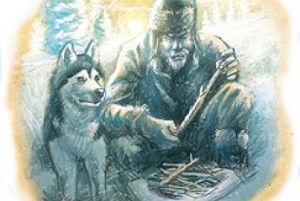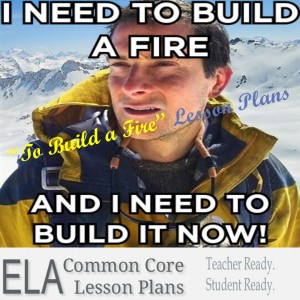To Build a Lesson Plan
Day had broken cold and grey, exceedingly cold and grey, when the man turned aside from the main office hallway and climbed the portable stairs. It was a steep climb, and he paused for breath at the top, excusing the act to himself by looking at his watch. It was seven o’clock. There was no “To Build a Fire” lesson plans nor hint of “To Build a Fire” lesson plans, though he was supposed to teach Jack London’s “To Build a Fire” 1st period.
There seemed an intangible pall over the face of things, a subtle gloom that made the day dark, and that was due to the absence of even a “To Build A Fire” summary or analysis. This fact did not worry the man. He was used to not having lesson plans. It had been days since he had any, and he knew that it would be a few more days before that uncheerful orb, the principal, would just peep into the room for an observation.
So as the principal popped his head in at 7:15 that very day, this teacher needed lesson plans and he needed them fast.
There’s really nothing we can do for him, but there is something we can do for you.
“To Build a Fire” Summary

The old-timer knows how cold 75 degrees below zero is. In fact, he warned the man not to travel when it’s 75 degrees below zero. Did I mention it’s 75 freaking degrees below zero? The old-timer also mentioned the stupidity of traveling alone in the Yukon when it’s 75 degrees below zero. The man didn’t listen, but he’s listening now.
You see, 75 degrees below zero causes spit to freeze before it hits the ground. 75 degrees below zero causes fingers to go numb in 15 seconds. This is how the man begins to learn just how cold 75 degrees below zero is. He finishes his learning after coming across a hot spring that has partially melted the ice that the man steps on.
When a man steps on partially unfrozen ice, it breaks. And when the ice breaks, man gets wet. And when a man gets wet when it’s 75 degrees below zero, he must build a fire. And build a fire the man does. Unfortunately, that fire is built below a Spruce tree. The heat from the fire affects the snow that’s been sitting on the Spruce tree branches. The snow from the Spruce tree branches falls and puts out the fire.
If the man’s mouth hadn’t been frozen shut, he would have probably sworn. Instead, he tried to rebuild the fire. He doesn’t succeed and freezes to death.
“To Build a Fire” Analysis

You’ll find a bevy of great stuff on this page. If that’s all you need then don’t buy this “To Build a Fire” Teaching Guide. It pretty much gives you a week’s worth of lessons, handouts, assignments, graphic organizers, and notes. It’s all ready to use. Just print out the pdf file and make copies. Boom! It’s a teaching breakthrough and I’m not talking about breaking through ice. Oh, it also includes rubrics and a 15 question multiple choice quiz. See, I told you all you have to do is make copies and let your expertise take care of the rest.
I read “To Build a Fire” again about 12 minutes ago. It’s even better than I remember. Here are some topics for discussion.
- Naturalism. Any teacher or student of literature needs to familiarize himself with Jack London. This informative page on Naturalism will help. If there’s anything in this story that needs pointed out, it’s the indifference of nature–the hostility of nature–a major tenet of Naturalism.
- Suspense. There’s really only one character in “To Build a Fire” and the entire story takes place in one basic location. Doesn’t sound very intense. But it is. Discuss and analyze how the masters create suspense and then observe how Jack London does it.
- Sensory Details. London himself makes the point that it’s impossible to describe what 75 degrees below zero feels like. That being said, London uses sensory details to describe the harsh setting, and he does it masterfully.
- Character Analysis. Many of the themes in “To Build a Fire” revolve around the hostility of the Yukon wilderness. But there’s more to it than the 75 degrees below zero. Notwithstanding the man’s foolishness, folly, and “lack of imagination,” his determination to survive the journey and his decision to face death with dignity proves somewhat redemptive in a Hemingway kind of way.
- Style and Tone. London’s direct and dispassionate style reflects the harsh setting of the Yukon. Remember: Form reflects content.
- The Hero’s Journey. According to the hero’s journey, the hero goes on a journey by leaving the ordinary world and facing trials. According to the hero’s journey, the hero dies or nearly dies but overcomes his trials in the end and returns to the normal world. A good topic for discussion is how our hero’s journey deviates from the norm. Does the man finally overcome his pride and foolishness by dying with dignity? Or does he simply fail?
Lesson Ideas
A story as great as “To Build a Fire” deserves more than a cursory read the story and answer the questions lesson plan. Here are some ideas. You’ll notice it mirrors the analysis section.
- Analysis Lesson Plan. It’s one thing to define Naturalism. Take it to the next level by identifying elements of Naturalism. And then take it to the next level by analyzing the significance of the examples to the overall theme of the story. This assignment is most easily accomplished with a 3-column chart.
- Suspense Analysis Chart. I’m a big fan of suspense. I’m a big fan of charts. I’m a really big fan of charts that analyze suspense. If you’re interested in a suspense analysis lesson plan, check out this suspense in “The Black Cat” lesson plan and apply it to “To Build a Fire.”
- Sensory Details Lesson Plan. London’s setting takes on a life of its own. How does London do it? Sensory details, my friend. Identify imagery/sensory details and analyze the details’ effects. This could also serve as inspiration for a using imagery writing assignment or a springboard for a revising horrible, crappy essays writing assignment.
- Themes. OK, I’m not even going to pretend that every single lesson plan I create doesn’t involve a graphic organizer of some type. I’ll also own up to using graphic organizers to trick students into thinking analytically. And I’ll also fess up to teaching students how to write analysis using the graphic organizers they complete. Guilty as charged. There are many themes in “To Build a Fire.” Find evidence for each one by (you guessed it) creating a two column chart instructing students to find evidence to support various themes in the story.
Guess I’ll throw you some ELA Common Core Standards
- RL.9-10.1 Cite strong and thorough textual evidence to support analysis of what the text says explicitly as well as inferences drawn from the text.
- RL.9-10.2 Determine a theme or central idea of a text and analyze in detail its development over the course of the text, including how it emerges and is shaped and refined by specific details; provide an objective summary of the text.
- RL.9-10.5 Analyze how an author’s choices concerning how to structure a text, order events within it (e.g., parallel plots), and manipulate time (e.g., pacing, flashbacks) create such effects as mystery, tension, or surprise.
- W.9-10.2 Write informative/explanatory texts to examine and convey complex ideas, concepts, and information clearly and accurately through the effective selection, organization, and analysis of content.
-
RL.11-12.9 Demonstrate knowledge of eighteenth-, nineteenth- and early-twentieth-century foundational works of American literature, including how two or more texts from the same period treat similar themes or topics.
-
RL.11-12.2 Determine two or more themes or central ideas of a text and analyze their development over the course of the text, including how they interact and build on one another to produce a complex account; provide an objective summary of the text.
Last Updated on July 13, 2021 by Trenton Lorcher
